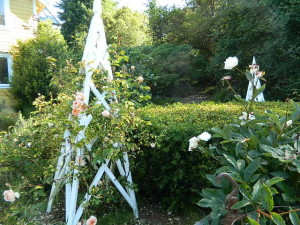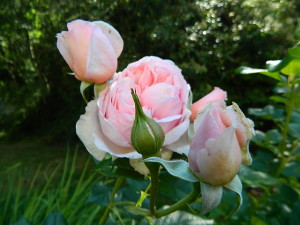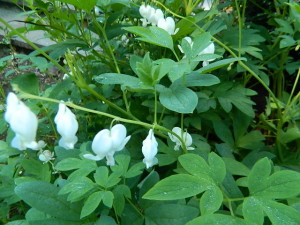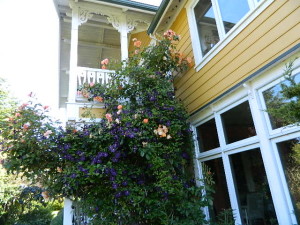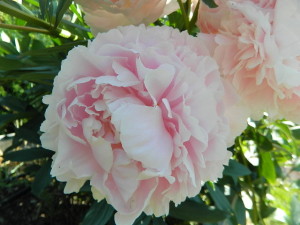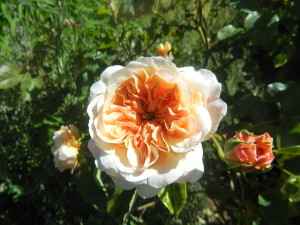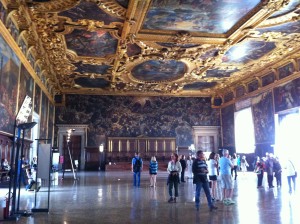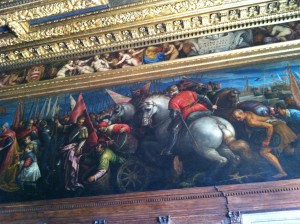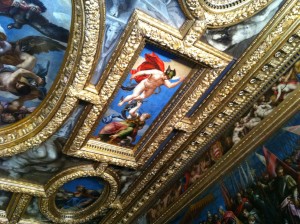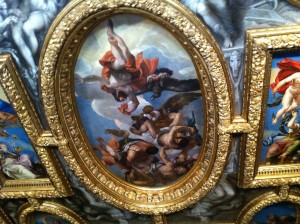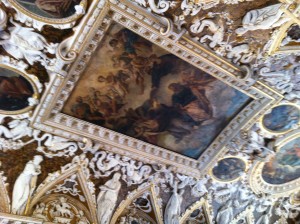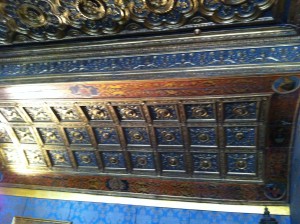This blog will take you to places you’ve always wanted to see and to some you may only have heard of. Its purpose – to immerse you in extraordinary tastes and colors, smells, sights and experiences, infecting you, or perhaps aggravating, an already serious case of wanderlust.
Many thanks for visiting Foreign Writes. Your comments are always welcome. Hope you’ll be back soon!
To view comments or to leave one, please click on the title of the post. Click on photos to enlarge.
Peru – Lima – Treasures
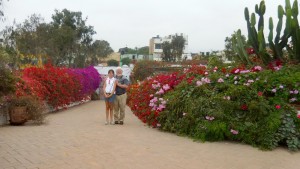
 Sometimes guide books hype an attraction and the reality disappoints, but sometimes the words don’t do it justice, as was the case at Museo Larco. Click on photos to enlarge.
Sometimes guide books hype an attraction and the reality disappoints, but sometimes the words don’t do it justice, as was the case at Museo Larco. Click on photos to enlarge.
We enter through high walls covered in bougainvilla in every shade from orange through deepest purple, and ascend the walkway to an exquisite 18th century viceroy’s mansion. It is now a private museum housing Rafael Larco Hoyle’s collection of pre-Colombian artifacts from Peru’s many ancient cultures, some dating back 10,000 years. The Incas were late comers!
The museum’s displays are works of art in themselves, perfectly lighted, with 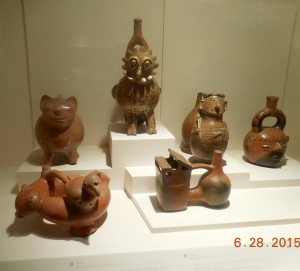 clear explanations as to period, culture, and use. Pottery dominates,
clear explanations as to period, culture, and use. Pottery dominates,
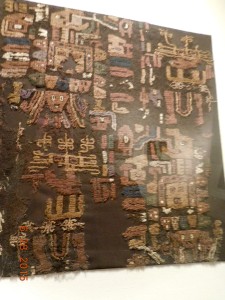 but there are astounding weavings as well. One surviving sample holds the world record at 325 threads per inch.
but there are astounding weavings as well. One surviving sample holds the world record at 325 threads per inch.
The exhibit concludes with displays of silver 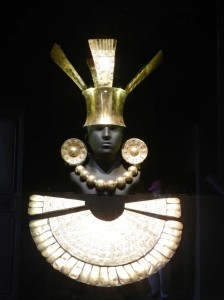 and gold ornamentation whose colors and gleam were used by rulers to establish their links with the moon and sun gods worshipped by their subjects.
and gold ornamentation whose colors and gleam were used by rulers to establish their links with the moon and sun gods worshipped by their subjects.
As impressive as the museum itself is the 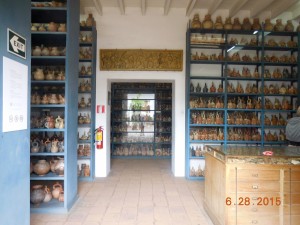 series of storerooms, open to the public, where the remainder of the 50,000 piece collection is stored.
series of storerooms, open to the public, where the remainder of the 50,000 piece collection is stored.
Decending a broad walkway from the museum, we enter a garden 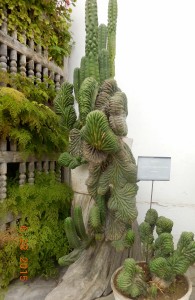 filled with plants, exotic enough to have escaped from dreams
filled with plants, exotic enough to have escaped from dreams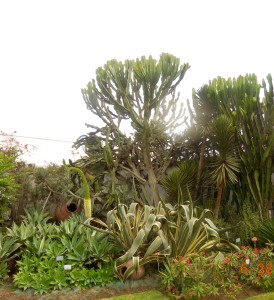 .
.
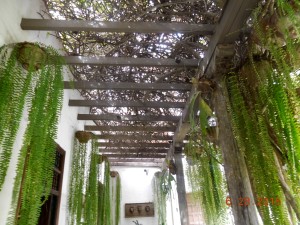 The garden is enclosed by a serene restaurant, draped in ferns, where we enjoy yummy individual quiches and fresh limeades.
The garden is enclosed by a serene restaurant, draped in ferns, where we enjoy yummy individual quiches and fresh limeades.
One delight after another.
June – Busting Out All Over
In a couple of weeks, Foreign Writes will be on the move to an exotic location – the Peruvian Amazon! Hope you’ll come along on the adventure.
It’s hard to beat Port Townsend’s summer, but it usually settles in after what we refer to as ‘Juneuary’, a month of widespread moaning, with predictions that summer will never come. Not this year! After a winter with few freezing temperatures and almost no snow, June burst upon us in a big way. Everything is weeks early, from roses to strawberries, there’s not a cloud in the sky, and temps are pushing 80. Summer is here, and how! Here’s the proof:
Working Together – Sudan, Somalia and Russian Nuclear Subs
I had the pleasure of speaking to the assembled delegates at the opening ceremony of the Port Townsend High School 2015 Model United Nations General Assembly. They were dressed and polished for the event as they marched in, each delegation accompanied by appropriate national music.
I spoke to them about working together. Here are some excerpts:
In 1987 I arrived in Addis Ababa, Ethiopia to head the Political and Economic Section of the U.S. Embassy. Our overriding goal was to get aid to northern Ethiopia, then entering a devastating drought. But only a few months 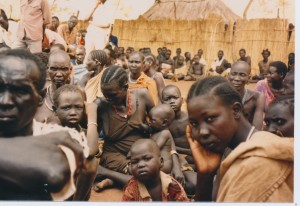 after I arrived we started receiving horrifying reports of Sudanese children near starvation crossing into Ethiopia on its remote Western border. Children came in their thousands, mostly boys, mostly ten years old or younger. Civil war between the Government in the North and the rebels in South Sudan had been raging for years, but now government troops and planes were wiping out whole villages.
after I arrived we started receiving horrifying reports of Sudanese children near starvation crossing into Ethiopia on its remote Western border. Children came in their thousands, mostly boys, mostly ten years old or younger. Civil war between the Government in the North and the rebels in South Sudan had been raging for years, but now government troops and planes were wiping out whole villages.
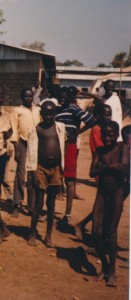 In Sudan, pre-adolescent Sudanese boys are responsible for herding cattle, living with their animals, away from their village. They were often the only ones left alive after a government attack. They walked for weeks and some for months, living off bugs, grass, whatever they could scavenge. Many died from animal attacks, from drowning in the rivers they had to cross, from disease or starvation. Many of the boys also carried their younger sisters or brothers. They arrived in Ethiopia as skeletons, some too weak to eat.
In Sudan, pre-adolescent Sudanese boys are responsible for herding cattle, living with their animals, away from their village. They were often the only ones left alive after a government attack. They walked for weeks and some for months, living off bugs, grass, whatever they could scavenge. Many died from animal attacks, from drowning in the rivers they had to cross, from disease or starvation. Many of the boys also carried their younger sisters or brothers. They arrived in Ethiopia as skeletons, some too weak to eat.
What to do?
Once international aid had been committed, representatives of the United Nations High  Commission for Refugees, the World Food Program, World Health Organization, Unicef and donor countries worked together frantically in Addis Ababa on the Refugee Task Force, to overcome the many obstacles to getting help to the children.
Commission for Refugees, the World Food Program, World Health Organization, Unicef and donor countries worked together frantically in Addis Ababa on the Refugee Task Force, to overcome the many obstacles to getting help to the children.
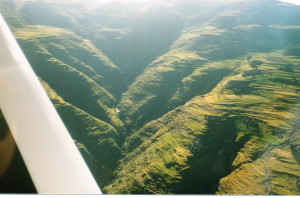 Transporting food and medicine from the Red Sea ports to Ethiopia’s Western border meant crossing the entire country, over mountains, on barely passable roads. Ethiopia was also in the midst of a civil war and the truck convoys were vulnerable to attack – often by underfed, underpaid Ethiopian government troops. Being a truck driver was a very dangerous
Transporting food and medicine from the Red Sea ports to Ethiopia’s Western border meant crossing the entire country, over mountains, on barely passable roads. Ethiopia was also in the midst of a civil war and the truck convoys were vulnerable to attack – often by underfed, underpaid Ethiopian government troops. Being a truck driver was a very dangerous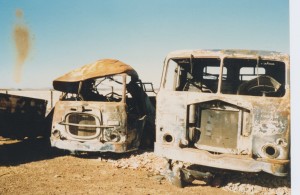 occupation, and many were lost. One of our jobs was to cajole, threaten or shame the Marxist Ethiopian government into stopping those attacks.
occupation, and many were lost. One of our jobs was to cajole, threaten or shame the Marxist Ethiopian government into stopping those attacks.
Once the food started arriving, miracles happened. The resilience of the children was breathtaking. By the time I took these pictures, a couple of months later, those near death walking skeletons, were laughing, singing,  soccer playing kids.
soccer playing kids.
Working together.
Just a few months later, the government of Somalia bombed Hargeisa, Somalia’s second biggest city, in response to a clan uprising. 400,000 Somali’s, mostly city dwellers, fled across Ethiopia’s eastern border – – into the desert, into nothingness. No trees, no shelter, no food, and most urgently, no water. Again the Refugee Task Force was faced with huge challenges. UNHCR, other UN agencies, donor countries and NGOs including Save the Children, CARE and Oxfam mobilized. How to sustain so many in the desert? We organized a fleet of 60 tankers to bring water, round-the clock, from Jijiga, 60 km. away. No one died of thirst.
Working together.
Just beyond Norway’s northern most border, above the Arctic Circle, lies the city of Murmansk, Russia – home to Russia’s Northern fleet of nuclear submarines. Now the graveyard for dozens of them.
In 1995 I was assigned to the U.S. Embassy in Oslo, Norway as Deputy Ambassador. The Cold War was over, Russia 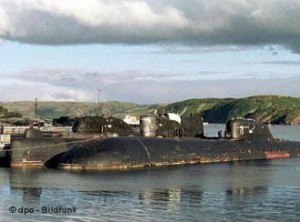 was strapped for cash, and there were 100 Soviet era nuclear submarines rotting in Murmansk harbor, waiting to be decommissioned. Recently the electric power to one of them had been cut off and a meltdown barely averted. Norway was scared, with good reason. Russia had already scuttled 20 old subs in Arctic waters and Norway feared for its billion dollar fishing industry, among other concerns. The Norwegians came to us proposing a joint effort to address this disaster in the making. The U.S. Environmental Protection Agency was interested as was the Defense
was strapped for cash, and there were 100 Soviet era nuclear submarines rotting in Murmansk harbor, waiting to be decommissioned. Recently the electric power to one of them had been cut off and a meltdown barely averted. Norway was scared, with good reason. Russia had already scuttled 20 old subs in Arctic waters and Norway feared for its billion dollar fishing industry, among other concerns. The Norwegians came to us proposing a joint effort to address this disaster in the making. The U.S. Environmental Protection Agency was interested as was the Defense 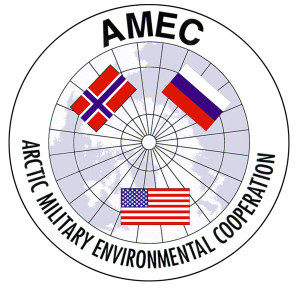 Department. After a year of negotiation, the Arctic Military Environmental Cooperation pact was signed by the U.S., Norwegian and Russian defense ministers. Norway supplies money, Russia supplies personnel and the U.S. supplies technical support and funds.
Department. After a year of negotiation, the Arctic Military Environmental Cooperation pact was signed by the U.S., Norwegian and Russian defense ministers. Norway supplies money, Russia supplies personnel and the U.S. supplies technical support and funds.
It is a start.
Working together.
Italy – Venice – Ulterior Motives
We linger in Venice. Not that anyone really needs an excuse, but there is another reason not to rush. I’m here to absorb as much of the city as I can – it’s sights, smells, sounds. The feel of it. It’s what I need to make the swirling thoughts in my head come alive, to create the world of Catarina d’Armano, who will come of age in the Venice of the 1500s, at the apogee of its splendor. Many thanks to La Serenissima. Remove motorized boats and tourists, and there is the city, much as it was then. I have only to repopulate it with men in their distinctive black hats and knee length, wide sleeved black coats (vestas) serving as a background for women clothed in Venice-woven fabrics of elaborate silk brocades and velvets, in colors bright as the palazzos they lived in.
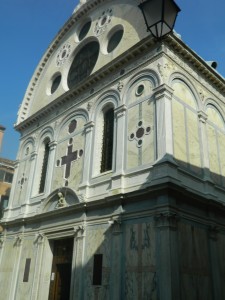 So, here I am, walking the lanes, crossing the bridges, gasping at the vistas, looking
So, here I am, walking the lanes, crossing the bridges, gasping at the vistas, looking 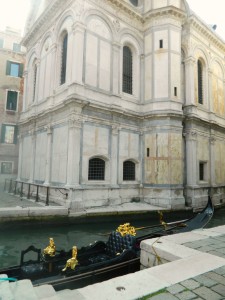 for the perfect palazzo for my heroine. I have decided that she should live close to my favorite of all Venice’s churches – St. Maria dei Miracoli, a jewel box – very small by Venitian standards.
for the perfect palazzo for my heroine. I have decided that she should live close to my favorite of all Venice’s churches – St. Maria dei Miracoli, a jewel box – very small by Venitian standards.
It all began in the summer of 1480, when a painting of the Virgin and child, which hung in a niche a few steps away from the current church, attracted enormous devotion because of recurring events starting with the healing of a woman stabbed by a relative. The family owning the painting proposed that a chapel be built to house it. Money poured in from the faithful (indulgences were granted for contributions) and in 1489, the miraculous picture was moved to its new home.
Clad in veined, pale peach marble panels, set between classic pillars upholding rounded arches, it is further decorated with porphyry lunettes, and the whole thing glows.
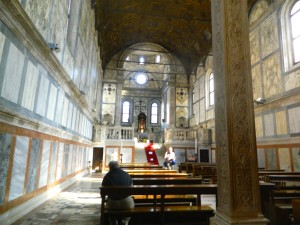 The interior, with the same pale marble, gives the feeling of a fragile egg shell, almost translucent.
The interior, with the same pale marble, gives the feeling of a fragile egg shell, almost translucent.
Above is another one of those marvelous Venitian ceilings, vaulted, with 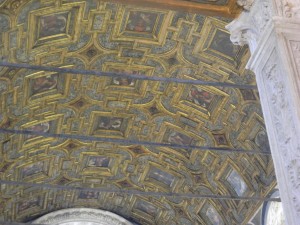 paintings of patriarchs and prophets set off by elaborate gold leaf. The raised choir sheltered the chorus of St. Clares resident in the nunnery across the way. A dozen steps above the congregation is the altar, crowned by the famous painting. It is perfection.
paintings of patriarchs and prophets set off by elaborate gold leaf. The raised choir sheltered the chorus of St. Clares resident in the nunnery across the way. A dozen steps above the congregation is the altar, crowned by the famous painting. It is perfection.
 We walk the narrow lanes leading from the Campo, turn a corner, and there it is. Catarina’s palazzo. Situated with canals on two sides, it rises from the water, pale rose, with a marble balustrade flying the banner of Venice – the golden winged lion
We walk the narrow lanes leading from the Campo, turn a corner, and there it is. Catarina’s palazzo. Situated with canals on two sides, it rises from the water, pale rose, with a marble balustrade flying the banner of Venice – the golden winged lion 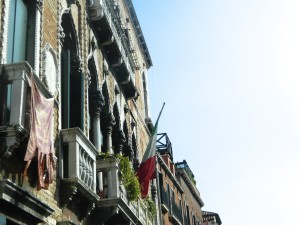 on a scarlet background. Ca’ Pizzani.
on a scarlet background. Ca’ Pizzani.
I have found my inspiration.
Italy – Venice – Looking Up
Venice – most improbable of cities. As we walk its streets, catching our breaths at one too-perfect vista after another, the question is always there. How could it happen? How could a collection of tiny islands in a vast marsh go from a hiding place for a straggle of refugees fleeing for their lives from the waves of Huns, Lombards and Goths that flooded the remains the Roman Empire, to the richest city in Europe, (and without a doubt, the most beautiful) in a period of 400 years or so? This is, of course, way too big a topic for Foreignwrites to take on, but why let that stop me? So here, reduced to a ridiculous few, are my thoughts –
-Salt – The Venetians made lemonade from their lemons. They trapped the shallow waters of their vast lagoon, made salt, and and marketed it up and down the coast, bringing back the essentials they needed for survival. And their shallow sea protected them from invasion – only Venetian sailors knew the locations of the deep channels they had dredged for their own use.
-Ships – With more capacity, these early entrepreneurs could bring back goods, in excess of their needs, to trade with the mainland. Venice sat in the ideal position between east and west. Russian and Balkan slaves, furs, woolen goods, wine, metal, and silver from the north filled Venetian ships bound for Alexandria and Constantinople. Spices and silks filled their holds on the return voyage. Eventually, the Arsenale, Venice’s ship yard, employed over 3,000 workers.
-Self-interest – These fiercely independent early businessmen had no interest in being ruled by Pope, king, or one another. They came together in the world’s first Chamber of Commerce (known as the Grand Council) for the primary purpose of promoting business. They elected a non-hereditary CEO (The Doge) to preside over Venice Incorporated. It worked. And lasted for 1,000 years.
Venice’s superb navy made the Eastern Med and the Adriatic a Venetian lake for hundreds of years, but there was another way they used wealth to enhance security. Venice drew visitors from both East and West, and what a show the Venetians put on. Is it spiritual glamour that impresses you? Venice has 50 sumptuous churches – AND the remains of St. Mark. Do you prefer another type of glamour? Venice was renowned for its beautiful blondes. And its 9,000 prostitutes, the most famous of which received visiting kings and held literary salons. Is it art that impresses? Have a look at the work of the Belini brothers, Titian, Tintoretto, Veronese, et.al. The pomp of Venetian ceremony was unrivaled. The Doge led flotillas of gilt-clad boats, velvet flags snapping, down the Grand Canal past the glittering mosaic-encrusted walls of sumptuous ‘palazzi’ floating miraculously on the water. And the message the visitors took home was “Don’t mess with Venice.”
With a little imagination, exploring the churches, the Doge’s palace, and the many other remains of this golden time, you are as over-awed as were those visitors. Just look up. Ceilings – hundreds of them, so gorgeous they make your jaw drop – just as they were designed to do




